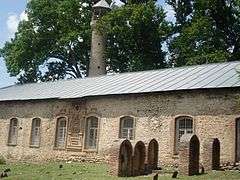Muhammad Husayn Khan Mushtaq
Muhammad Husayn Khan Mushtaq (Azerbaijani: محمد حسین خان موشتاق / Məhəmməd Hüseyn xan Müştaq), was the third khan of Shaki. He was described as courageous but ruthless man by Abbasgulu agha Bakikhanov.[1]
| Muhammad Husayn | |
|---|---|
| Khan of Shaki | |
| Reign | 1759 – 1780 |
| Predecessor | Aghakishi beg |
| Successor | Haji Khan |
| Died | August, 1780 |
| Burial | |
| House | House of Black Monk |
| Father | Hasan agha |
Early years
He was a grandson of Haji Chalabi. His father Hasan agha died in a battle against Afsharid army. After murder of his uncle Aghakishi beg, he fled to Shirvan and appealed help from Aghasi Khan, who in turn defeated Gazikumukh armies and retook Shaki.
Reign
Despite his succession, naib of Arash, Malik Ali, who was now styled "Sultan of Arash" did not acknowledge his suzerainty. Only in 1761 he was put under vassalage of khanate thanks to interference of Fatali khan Afshar who was at time campaigning in Karabakh.[2] Malik Ali was killed shortly by khan.
He became allied to Fatali khan of Quba by 1760s in order to invade Shirvan Khanate. In order to start negotiation, Muhammad Said khan of Shirvan himself went to Fatali Khan's court and his brother Aghasi khan headed to Muhammad Husayn's. However, Aghasi khan was blinded by Muhammad Husayn, while his brother imprisoned. Khanate was invaded by 700 Shaki soldiers, whereas Quba army was as strong as 7000. Khanate was divided between Shaki and Quba Khanates who appointed their own governors. Western part was government by Manaf Zarnavai.
Soon in August 1768, an uncovered plot worsened the relation between allies, Manaf Zarnavai who was instructed by Muhammad Husayn khan was aiming to overthrow Quba rule and incorporate Shirvan to Shaki as a whole. However their conspiracy were found by Fatali khan who invaded Agsu on 17 August 1768 and killed Manaf. Shaki armies were crushed by Quba and Gazikumukh alliance on 20 September 1768,[3] Shirvan was fully annexed to Quba Khanate. Peace agreement was signed on July 1769.
Death
While he managed to keep his throne, he was not unrivalled, his uncle Jafar agha was a popular rival, who claimed the throne by virtue of being son of Haji Chalabi. Husayn khan chose to murder him in 1770, which caused his another uncle Haji Abdulqadir to rebel and flee to mountains. Abdulqadir was allied to Arash Sultanate beys, Haji Chalabi's cousin Haji Rasul and other nobility members who were feeling grudge of because of the recent execution. Muhammad Husayn send his son Muhammad Hasan in seeking negotiation, however he was imprisoned and sent to Karabakh. Khan later was ambushed by his uncle Haji Abdulqadir in 1780 who along with his 70 men invaded the khan's house and captured him while killing his son Ahmad. He was forced to resign between 22–29 August and subsequently killed.[4]
Family
He had four sons: Muhammad Hasan khan, Fatali khan, Salim khan, Ahmad and a daughter Tubu khanum, who married to Ibrahim Khalil khan.
Legacy
His reign is mostly known for cultural activities as he was interested in arts. Palace of Shaki Khans was one of his main ambitious projects alongside Shakikhanov's Palace and Shaki Khan's Mosque. Along with these, he also wrote poetry under pen name Müştaq (Enamored).
Gallery
 Shaki Khan's Mosque
Shaki Khan's Mosque- House of Shakikhanovs
- Palace of the Shaki khans'
References
- Bakikhanov, Abbasgulu agha (1951). Gulustani Iram (PDF) (in Azerbaijani). Baku. p. 172. ISBN 995221045-3. OCLC 837882352.CS1 maint: ignored ISBN errors (link)
- Shakikhanov, Karim agha. "KERIM AGA FATEH. BRIEF HISTORY OF SHEKI KHANS". www.drevlit.ru (in Russian). Retrieved 2019-07-01.
- ABDULLAEV, Gasi Benbud (1965). Azerbaijan in the XVIII century and its relationship with Russia. [With maps.] (in Russian). pp. 221–225.
- "Reports of A. V. Suvorov to Prince G. A. Potemkin". www.vostlit.info (in Russian). Retrieved 2019-07-01.